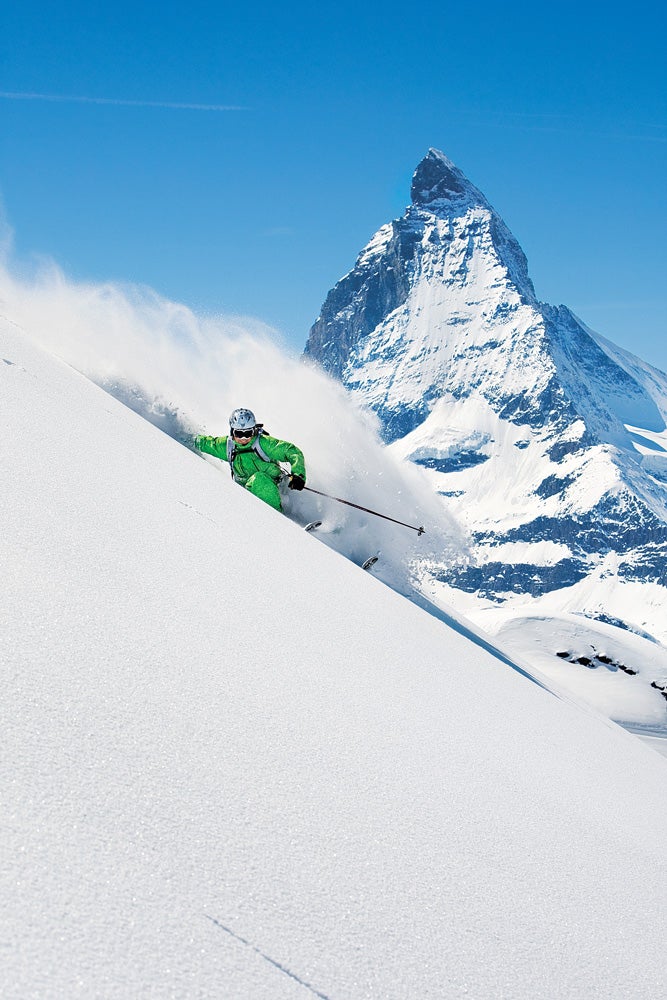Europe's Five Stars, Part 1: Zermatt, Switzerland

Rider: Matt Reardon Location: Zermatt
Farmers, mountain climbers, wine-sipping tourists…no one is immune to the real-life glory of the Matterhorn.
It’s 11 o’clock on a bluebird day in Zermatt. The hooked pyramid of the Matterhorn pierces a cloudless sky, and creamy spring snow covers the slopes, which should be crowded but aren’t. The action, instead, is in the many trailside cafés, where “skiers” sip coffee and nibble pastries.
To be sure, Zermatt’s skiing is some of the best in the world. Its 153 miles of trails span three mountains—Klein Matterhorn, Gornergrat and Rothorn. Visitors can ski into Italy for the day, and, thanks to the Theodul Glacier, the season never ends. But European visitors are as fond of the food and wine as they are of the skiing, and few places capture this ski-to-eat philosophy better.
Zermatt was a quiet farming hamlet until the 19th century, when it was discovered by European aristocrats and alpinists hungry to conquer the Matterhorn. Lifts started spinning in 1928. These days, the old wooden farmhouses remain, but lively après-ski bars, charming B&Bs, and upscale restaurants now fill out the village core. Zermatt is car-free, and horse-drawn carriages rumble up the cobblestone streets. Though teeming with all of the amenities of a world-class resort, in the summer you’ll still hear cowbells clanging loudly through town as shepherds drive their herds up to higher pastures, causing some locals to complain. Believe it or not, cowbell noise pollution is one of the town’s most contentious issues.
After a morning spent skiing the Breithorn, a popular ski tour easily assessed from the resort, my guide and I head to lunch at Chez Vrony, an 18th-century farmhouse. We sit on a deck overlooking a sleepy farming village and tuck into platters of dried local beef, homemade sausage and alpine cheeses. Around us, people pop bottles of rosé, soak up the sun and nap on comfy deck chairs.
After lunch, we carve up soft corn snow, then head to the Hennu Stall, an open-air bar on the lower part of the mountain. The music is live, and by four o’clock girls are dancing on tables. After drinks, we make our way to town, passing the Champagne Bar, an old farmhouse tucked into the woods off Sunnegga’s home run. Back in town, Zermatt’s cobblestone streets clip-clop with contented skiers, weathered mountain guides and slick Euros prosting and laughing over steins of Carlsberg lager. I say goodbye to my guide, who disappears into the swirl, skis over one shoulder and a pitchfork over the other.
REST
The sleek Omnia, with 30 balconied rooms set on a rock shelf above Zermatt, is a modernist’s paradise dressed in dark granite, white oak and clean lines. Request a room with a view of the Matterhorn.
MUST DO
The Matterhorn wasn’t conquered until 1865, when the seven members of Edward Whymper’s party finally reached the summit. Only three survived the descent. For more on this and other fascinating mountaineering stories, visit the Matterhorn Museum.
EAT & DRINK
The restaurant inside the boutique Hotel Cervo (another great lodging option) is becoming the go-to spot for creatively updated Swiss fare.
DETAILS
Fly into either Zurich or Geneva and take the train to Zermatt. The town is car-free anyway, so unless you’re road-tripping elsewhere, you won’t need a vehicle.